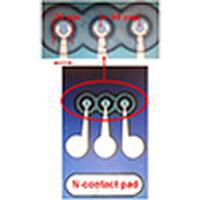Our official English website, www.x-mol.net, welcomes your
feedback! (Note: you will need to create a separate account there.)
High-brightness and high-speed vertical-cavity surface-emitting laser arrays
Optica ( IF 8.4 ) Pub Date : 2020-03-25 , DOI: 10.1364/optica.383406 Zuhaib Khan , Jie-Chen Shih , Rui-Lin Chao , Tzong-Liang Tsai , Hsin-Chuan Wang , Gang-Wei Fan , Yu-Chen Lin , Jin-Wei Shi
Optica ( IF 8.4 ) Pub Date : 2020-03-25 , DOI: 10.1364/optica.383406 Zuhaib Khan , Jie-Chen Shih , Rui-Lin Chao , Tzong-Liang Tsai , Hsin-Chuan Wang , Gang-Wei Fan , Yu-Chen Lin , Jin-Wei Shi

|
High-power vertical-cavity surface-emitting laser (VCSEL) arrays, which can serve as the light source in modern lidar and three-dimensional optical sensing systems, have recently attracted a lot of attention. In these types of systems, the time-of-flight (ToF) technique, based on the round-trip time of short optical pulses is usually adopted. Further enhancement of the ranging distance and depth resolution in these ToF driven systems by the incorporation of a VCSEL array with a high available power, high brightness (narrow divergence angle), and fast response time is highly desirable. However, a large number of light emission apertures (several hundreds) in the VCSEL array is usually necessary to raise the output power level to several watts. This leads to a large parasitic capacitance and the RC-limited bandwidth may become the dominant limiting factor of the speed of the high-power VCSEL array. In this work, Zn-diffusion and oxide-relief apertures are used to manipulate the optical modes and reduce the parasitic capacitance, respectively, in a unit device for a 940 nm VCSEL array. The demonstrated VCSEL array has a quasi-single-mode output, high available power (4 W; 1% duty cycle), narrow divergence angle (${\sim}{14}^\circ $ at ${{1/e}^2}$) under maximum output power, and a fast rise time ($ {\lt} {100}\;{\rm ps}$). These results open up new possibilities for further enhancing the performance of ToF sensing systems at the 940 nm wavelength.
中文翻译:

高亮度和高速垂直腔面发射激光器阵列
可以用作现代激光雷达和三维光学传感系统中的光源的高功率垂直腔面发射激光器(VCSEL)阵列最近引起了很多关注。在这些类型的系统中,通常采用基于短光脉冲往返时间的飞行时间(ToF)技术。通过并入具有高可用功率,高亮度(窄发散角)和快速响应时间的VCSEL阵列,进一步增强这些ToF驱动系统中的测距距离和深度分辨率。但是,通常需要VCSEL阵列中的大量发光孔(数百个)才能将输出功率水平提高到几瓦。这导致较大的寄生电容,RC限制带宽可能成为大功率VCSEL阵列速度的主要限制因素。在这项工作中,在940 nm VCSEL阵列的单位器件中,分别使用Zn扩散孔和氧化物扩散孔来控制光学模式并减小寄生电容。演示的VCSEL阵列具有准单模输出,高可用功率(4 W; 1%占空比),发散角窄($ {\ sim} {14} ^ \ circ $在$ {{1 / e} ^ 2} $的情况下,输出功率最大,并且上升时间快($ {\ lt} {100} \ ;; {\ rm ps } $)。这些结果为进一步增强ToF传感系统在940 nm波长下的性能开辟了新的可能性。
更新日期:2020-03-25
中文翻译:

高亮度和高速垂直腔面发射激光器阵列
可以用作现代激光雷达和三维光学传感系统中的光源的高功率垂直腔面发射激光器(VCSEL)阵列最近引起了很多关注。在这些类型的系统中,通常采用基于短光脉冲往返时间的飞行时间(ToF)技术。通过并入具有高可用功率,高亮度(窄发散角)和快速响应时间的VCSEL阵列,进一步增强这些ToF驱动系统中的测距距离和深度分辨率。但是,通常需要VCSEL阵列中的大量发光孔(数百个)才能将输出功率水平提高到几瓦。这导致较大的寄生电容,RC限制带宽可能成为大功率VCSEL阵列速度的主要限制因素。在这项工作中,在940 nm VCSEL阵列的单位器件中,分别使用Zn扩散孔和氧化物扩散孔来控制光学模式并减小寄生电容。演示的VCSEL阵列具有准单模输出,高可用功率(4 W; 1%占空比),发散角窄($ {\ sim} {14} ^ \ circ $在$ {{1 / e} ^ 2} $的情况下,输出功率最大,并且上升时间快($ {\ lt} {100} \ ;; {\ rm ps } $)。这些结果为进一步增强ToF传感系统在940 nm波长下的性能开辟了新的可能性。











































 京公网安备 11010802027423号
京公网安备 11010802027423号